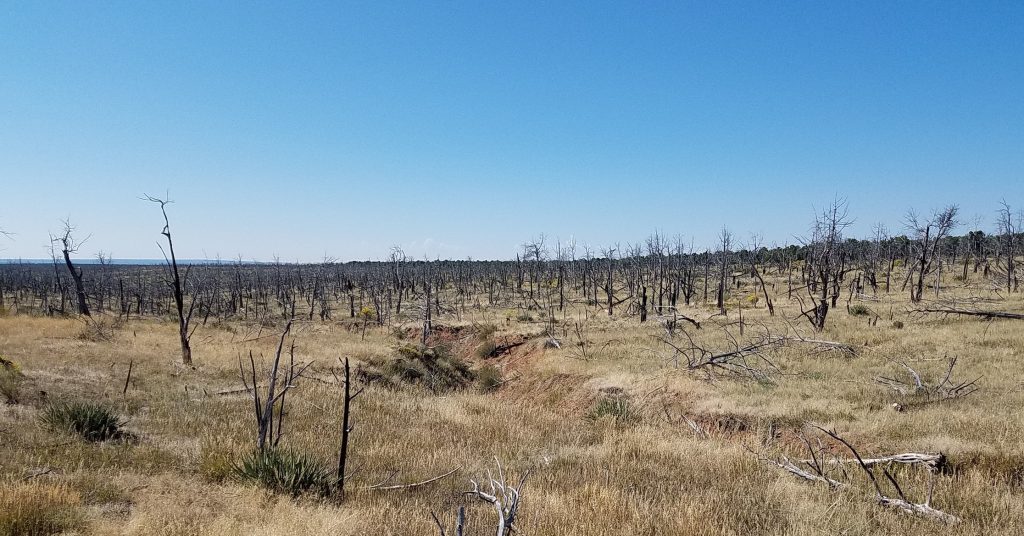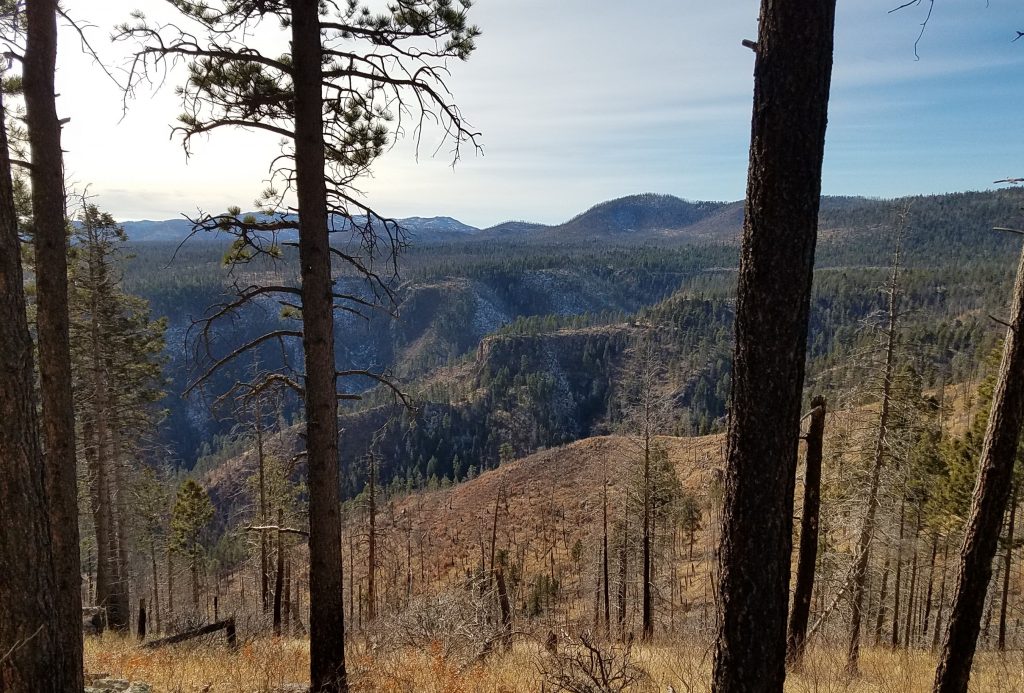Fires like the Cerro Grande fire in 2000 and the Las Conchas fire of 2011 are knocking down even fire-adapted ponderosa pine communities. The Las Conchas fire burned through more than 43,000 acres in 15 hours. Driven by strong winds that produced horizonal vortices (like tornadoes on their sides), the fire burned about an acre every second.

There is real chance that if fires like this persist that they will permanently deforest parts of the Southwest until recently covered by thick forests, converting them into bush or grassland, as forest gaps become so big that there is no seed source for regeneration or fire-prone brush burns so hot and so frequently that forests cannot reestablish.
Ponderosa pine are fire adaptive, even fire dependent. Fires are essential to the health of ponderosa pine forests. But it can get to be too much even for them. (The ponderosa ecology is analogous to longleaf pine, but the Southeast is not like the Southwest. Fire in the Southeast can destroy much of the above ground vegetation, but plants and trees will be back within a year or two. You can see the results of a prescribed fire in Virginia at this link. In the Southwest, the ground may stay barren for a long time. )
The hot fires in fire adapted ponderosa can be driven by winds up into the spruce-fir forests on top of the mountains destroying them too. Since these ecological communities are often remnants of climates of the last ice age clinging to “sky islands,” where altitude maintains the cooler climate, they may not come back until the next ice age.
Fires have been common in the Southwest for more than 10,000 years, but there is nothing in the historical record like the fires we have experienced in recent decades. They are altering rich ecological and cultural landscapes. We can blame climate change, and warmer and drier weather are certainly contributing to the situation, but changes in land management is the proximate cause, and would trouble even absent the climate changes.
Tom Swetnam, Professor Emeritus of Dendrochronology at the University of Arizona, studies historical ecological disturbances, using tools like tree ring analysis. He spoke at our National Tree Farm Leadership Conference in Albuquerque. Using tree rings, scientists have mapped the changing climate and conditions in the Southwest with decent precision going back more than 400 years and make decent estimates farther back.
The tree rings tell a story of wet and dry years and fires that go with them. Not surprisingly, fires are more common in dry years, but fire scars indicate that centuries ago fires were frequent but not very hot. The record of the area around the Jemez Mountains in northern New Mexico experienced frequent low-intensity burns until around 1680. After that, fires become less frequent but hotter. This fire regime persists until just before 1900, when fires are almost gone, until the serious upsurge a few decades ago. What happened?
The tree ring record fits well with the historical record if you know what was going on. Around 1600 Pueblo people lived in the mountains and on the plateaus, i.e. in the forests. They set fires to clear land, improve hunting or discourage insects, and sometimes cooking and campfires got out of hand. The Pueblo also used wood gathered from the nearby woods for fuel and building materials. They especially used small diameter wood for ramadas and roofs. In other words, they kept the woods clear of fuel that would drive large fires. The ponderosa pine forests of those days were open. We would call them park-like, with as few as twenty large trees per acre. When fires went through, they stayed on the ground, doing little hard to big trees, but conveniently marking them for our future study.
Spanish colonist and missionaries started showing up in growing numbers after 1600. This started to pull or drive some of the Pueblo out of their mountain homes. Others died of introduced diseases and later started to be the victims of raids by tribes made mobile by the newly introduced horses. No matter the reasons, the human population of the New Mexico mountains declined and so did the health of the forests. Fire became less common and more often ignited by lightning, but they were bigger and hotter.
(Nature does not always do better w/o human intervention. That is controversial, and it is my thought. I cannot attribute it to Mr. Swetnam. There is a dynamic balance to be struck.)
This less frequent but still common low-intensity fire regime continued until the late 1800s. That is when fire disappeared for around a century. We would be wrong to credit or blame fire suppression for most of this. It is true that settlers tended to put out fires and that roads and cultivated fields functioned as fire-breaks, but the big factor from around 1890-1945 was grazing. Sheep and cows grazed down the grass and w/o the grass to carry the fire, fires just did not get going. After 1945, fire suppression became a bigger deal. Suppression was enabled by technologies and techniques developed during World War II. Aircraft could stop and fight fires even in remote regions. They could also parachute in fire fighters and general organization and discipline appropriate to the exigencies of war translated from fighting war to fighting fire. In fact, the Forest Service and others approached the fight against fire with warlike vigor and metaphors.
And it seemed to work. Fires were suppressed most of the time. Trees grew thicker than ever and that seemed a good thing. Managing forests like a factory fit in well with organizational theories of the time. But fuels were building. Fire can be avoided and postponed but not banished.
This brought us to where we are today. Western forests are overgrown with trees and brush. We have come to see this as natural, but it is not. In a robust ponderosa forest, there are big trees and not much else near the ground. Over the last century, brush grew and wood lays on the ground. Beyond that, there are lots of trees of various heights. This provides ladders to pull fire from the ground to the canopy, where whole trees, even big ones are killed. This sets up a negative cycle, where the hot fires kill the big trees, allowing brush to grow in thick fueling other hot fires.
Managing this flammable situation is exacerbated by people moving into the woods and building homes, sometimes expensive ones, that need to be protected against the old nemesis of fire.
This is often called the Wildland-Urban Interface or the WUI (pronounced WOOEE). Most forest fire managers dislike WUI because it complicates their burn management and risks the lives of civilians and firefighters.
Swetnam, however, thinks that people can live in harmony in the woods, IF they do it right. The Pueblo lived in these fire-prone woods for hundreds of years. Their villages seem never to have been overtaken by fire. Their success depended on managing fuels, as described above. The Pueblo also practiced seasonal movement. During the winter, they hunkered down in central areas, but in summer they dispersed around the countryside. The result was fuel management, whether that was the goal.
The good news is that we can manage fire. If we recognize that we cannot banish fire, we can manage it. We can build in lots of places but not in all places. The bad news is that it is hard politically and socially to do the right thing even when we are reasonably sure we know the right thing. We will also almost always lack the public resources to do all that we can or should.
Above are notes and thoughts from todays Tree Farm National Leadership Conference and speaker Tom Swetnam.





